The Development of Renewable Energy in Mineral Resource Clusters—The Case of the Siberian Federal District
Abstract
1. Introduction
2. Research Methodology
2.1. Literature Review
2.2. Analysis of Current Trends in Renewable Energy Development
3. Results
3.1. The Role and Place of the Energy System of the Siberian Federal District in the Development of Russian Renewable Energy
3.2. Factors of Development of Renewable Energy in the Siberian Federal District
3.2.1. Saturation with Main Powerlines
3.2.2. Renewable Energy Investment
- -
- Wind Energy Development Fund, established in 2017 by RUSNANO JSC and Fortum PJSC. The renewable energy portfolio in 2021 amounted to 1.8 GW in 10 regions, including Siberia;
- -
- PJSC Fortum, which has been involved in the development of renewable energy since 2015, the founder is the Finnish energy concern Fortum (95% of the shares), the renewable energy portfolio is more than 2 GW, and is present in 12 regions, including Siberia;
- -
- JSC NovaWind, established in 2017 by the state-owned corporation ROSATOM, renewable energy portfolio: 2 GW, presence in the southern regions of Russia (not represented in Siberia);
- -
- PJSC Enel Russia, founded in 2004 by the Italian company Enel S.p.A. Renewable energy portfolio: 0.362 GW. Regions of presence: in the south and west of Russia (not represented in Siberia);
- -
- Hevel group of companies, established in 2009 by Renova Group of Companies (solar energy division). Renewable energy portfolio: more than 1.1 GW, 11 regions of presence, including Siberia;
- -
- PJSC RusHydro is a monopoly company in the hydropower market in Russia, with an installed capacity of 38 GW, of which 14 GW is in Siberia.
3.2.3. The Environmental Factor (Counteraction to Air Pollution by Fuel Energy Facilities)
3.2.4. Morbidity of the Population Associated with Environmental Pollution by Fuel Energy Facilities
3.2.5. Endowment with Fossil Fuels (Hard and Brown Coal, Natural Gas)
3.2.6. Demand for Energy from the Non-Industrial Sector (Tourism, Agriculture)
3.2.7. Forecasts and Challenges for Renewable Energy in Russia and Siberia
- REPowerEU (the plan of the European Commission to phase out the consumption of Russian fossil fuels by 2030, with main actions in 2022–2023) aims at increasing the share of renewable energy by 45% by 2030 (under the package “Fit for 55”), as well as to reduce greenhouse gas emissions by 55% by 2030 compared to the levels of 1990 and to achieve zero emissions by 2050. The plan includes the provision of grants for 300 billion EUR [102].
- Rooftop Solar (a pan-European initiative for the obligatory equipping of newly built residential and commercial buildings with solar panels) [103].
- EU Solar Energy Strategy, aimed at an additional input of 600 GW of installed capacity of solar power plants in the European Union by 2030 (twice the level of 2021) [104].
- Five-year energy technology development plan of the People Republic of China (a national initiative shifting the focus from fuel energy investment to renewable energy, with planned investments of more than USD 1 trillion) [105].
- Pinnapuram IRESP (India’s national program to create a global hub for the accumulation and transportation of renewable energy with a capacity of more than 100 GW) [106].
4. Discussion
- Stimulation of demand for renewable energy from distributed sources through the development of non-industrial businesses in the rural Siberian territories;
- Parallel tightening of environmental requirements and incentives for energy companies to diversify energy packages in favor of renewable energy through taxes and subsidies. It is important to note that, in order to accelerate the introduction of new renewable energy capacity in Siberia (with a target of 15% by 2035, excluding existing large hydroelectric power plants), it is necessary to quadruple the speed of this process and at least triple investment;
- Development of electrical powerlines in sparsely populated regions specifically for the transportation of energy from renewable sources, the creation of a wholesale market in the Siberian Federal District to radically reduce costs;
- Revision of the Russian Energy Strategy-2015 in terms of organizational and financial support for the development of renewable energy in Siberia. To this end, it would be expedient to create a Siberian energy strategy linking federal and regional investments with private ones.
5. Conclusions
Author Contributions
Funding
Institutional Review Board Statement
Informed Consent Statement
Data Availability Statement
Conflicts of Interest
References
- International Renewable Energy Agency (IRENA) Renewable Capacity Statistics 2022. Power Generation. Available online: https://energystats.enerdata.net/electricity/world-electricity-production-statistics.html (accessed on 21 March 2023).
- International Energy Agency. Renewables 2022. In Analysis and Forecast to 2027; IEA Publications: Paris, France, 2022; p. 159. Available online: https://iea.blob.core.windows.net/assets/ada7af90-e280-46c4-a577-df2e4fb44254/Renewables2022.pdf (accessed on 21 March 2023).
- World Population Review. Renewable Energy by Country 2023. Available online: https://worldpopulationreview.com/country-rankings/renewable-energy-by-country (accessed on 21 March 2023).
- Asikritov, V. The Use of Fossil Fuels Needs to be Reduced, and the Transition to Low-Carbon Energy is the “New Reality”. Greenpeace. 22.02.2023. Available online: https://greenpeace.ru/expert-opinions/2023/02/22/kak-budet-razvivatsja-vozobnovljaemaja-jenergetika-rossii-v-blizhajshie-gody/ (accessed on 21 March 2023).
- Tsimisaraka, R.S.M.; Xiang, L.; Andrianarivo, A.R.N.A.; Josoa, E.Z.; Khan, N.; Hanif, M.S.; Khurshid, A.; Limongi, R. Impact of Financial Inclusion, Globalization, Renewable Energy, ICT, and Economic Growth on CO2 Emission in OBOR Countries. Sustainability 2023, 15, 6534. [Google Scholar] [CrossRef]
- Amuda, Y.J.; Hassan, S.; Subramaniam, U. Comparative Review of Energy, Crude Oil, and Natural Gas for Exchange Markets in Nigeria, India and Bangladesh. Energies 2023, 16, 3151. [Google Scholar] [CrossRef]
- Borowski, P.F. Mitigating Climate Change and the Development of Green Energy versus a Return to Fossil Fuels Due to the Energy Crisis in 2022. Energies 2022, 15, 9289. [Google Scholar] [CrossRef]
- Wang, P.; Wang, M.; Zhou, M.; He, J.; Feng, X.; Du, X.; Wang, Y.; Wang, Y. The Benefits of the Clean Heating Plan on Air Quality in the Beijing–Tianjin–Hebei Region. Atmosphere 2022, 13, 555. [Google Scholar] [CrossRef]
- Barceló, E.; Dimić-Mišić, K.; Imani, M.; Spasojević Brkić, V.; Hummel, M.; Gane, P. Regulatory Paradigm and Challenge for Blockchain Integration of Decentralized Systems: Example—Renewable Energy Grids. Sustainability 2023, 15, 2571. [Google Scholar] [CrossRef]
- Rabbi, M.F.; Popp, J.; Máté, D.; Kovács, S. Energy Security and Energy Transition to Achieve Carbon Neutrality. Energies 2022, 15, 8126. [Google Scholar] [CrossRef]
- Halser, C.; Paraschiv, F. Pathways to Overcoming Natural Gas Dependency on Russia—The German Case. Energies 2022, 15, 4939. [Google Scholar] [CrossRef]
- Nevzorova, T.; Kutcherov, V. The Role of Advocacy Coalitions in Shaping the Technological Innovation Systems: The Case of the Russian Renewable Energy Policy. Energies 2021, 14, 6941. [Google Scholar] [CrossRef]
- Magasheva, I.S.; Lomakina, O.B. Competitiveness of the Renewable Energy Sector in Russia and Prospects for a New Government Support Program Until 2035. In Current Problems of the Global Environmental Economy Under the Conditions of Climate Change and the Perspectives of Sustainable Development. Advances in Global Change Research; Popkova, E.G., Sergi, B.S., Eds.; Springer: Cham, Switzerland, 2023; Volume 73, pp. 281–288. [Google Scholar] [CrossRef]
- Wang, C.-N.; Tibo, H.; Duong, D.H. Renewable Energy Utilization Analysis of Highly and Newly Industrialized Countries Using an Undesirable Output Model. Energies 2020, 13, 2629. [Google Scholar] [CrossRef]
- Salimi, M.; Amidpour, M. The Impact of Energy Transition on the Geopolitical Importance of Oil-Exporting Countries. World 2022, 3, 607–618. [Google Scholar] [CrossRef]
- Bartela, Ł.; Gładysz, P.; Ochmann, J.; Qvist, S.; Sancho, L.M. Repowering a Coal Power Unit with Small Modular Reactors and Thermal Energy Storage. Energies 2022, 15, 5830. [Google Scholar] [CrossRef]
- Chebotareva, G.; Tvaronavičienė, M.; Gorina, L.; Strielkowski, W.; Shiryaeva, J.; Petrenko, Y. Revealing Renewable Energy Perspectives via the Analysis of the Wholesale Electricity Market. Energies 2022, 15, 838. [Google Scholar] [CrossRef]
- Lanko, A.; de la Flor, F.J.S.; Uvarova, S.; Solovyeva, E. Analysis of Current Situation with Renewable Energy in Russia. In Networked Control Systems for Connected and Automated Vehicles. NN 2022. Lecture Notes in Networks and Systems; Guda, A., Ed.; Springer: Cham, Switzerland, 2023; Volume 509, pp. 1695–1703. [Google Scholar] [CrossRef]
- Xu, X.; Wang, Y.; Ruan, Y.; Wang, J.; Ge, K.; Zhang, Y.; Jin, H. Integrated Energy Planning for Near-Zero Carbon Emission Demonstration District in Urban Areas: A Case Study of Meishan District in Ningbo, China. Energies 2022, 15, 874. [Google Scholar] [CrossRef]
- Vukovic, N.A.; Nekhorosheva, D.E. Renewable Energy in Smart Cities: Challenges and Opportunities by the Case Study of Russia. Smart Cities 2022, 5, 1208–1228. [Google Scholar] [CrossRef]
- Vukovic, N.; Koriugina, U.; Illarionova, D.; Pankratova, D.; Kiseleva, P.; Gontareva, A. Towards Smart Green Cities: Analysis of Integrated Renewable Energy Use in Smart Cities. Strateg. Plan. Energy Environ. 2023, 40, 75–94. [Google Scholar] [CrossRef]
- Bedi, P.; Goyal, S.B.; Rajawat, A.S.; Shaw, R.N.; Ghosh, A. Application of AI/IoT for Smart Renewable Energy Management in Smart Cities; Piuri, V., Shaw, R.N., Ghosh, A., Islam, R., Eds.; AI and IoT for Smart City Applications. Studies in Computational Intelligence; Springer: Singapore, 2002; Volume 1002, pp. 115–138. [Google Scholar] [CrossRef]
- Calzada, I. Democratising Smart Cities? Penta-Helix Multistakeholder Social Innovation Framework. Smart Cities 2020, 3, 1145–1172. [Google Scholar] [CrossRef]
- Ahlmeyer, F.; Volgmann, K. What Can We Expect for the Development of Rural Areas in Europe?–Trends of the Last Decade and Their Opportunities for Rural Regeneration. Sustainability 2023, 15, 5485. [Google Scholar] [CrossRef]
- Lisova, T.; Sharapova, S.; Bredikhina, V.; Leiba, L. Sustainable Development of Rural Areas in the Conditions of Globalization. J. Environ. Manag. Tour. 2023, 14, 217. [Google Scholar] [CrossRef]
- Shanxiang, W.; Wen, J.; Hummera, S. The impact of renewable energy transition, green growth, green trade and green innovation on environmental quality: Evidence from top 10 green future countries. Front. Environ. Sci. 2023, 10, 1076859. [Google Scholar] [CrossRef]
- Hafeez, M.; Rehman, S.U.; Faisal, C.M.N.; Yang, J.; Ullah, S.; Kaium, M.A.; Malik, M.Y. Financial Efficiency and Its Impact on Renewable Energy Demand and CO2 Emissions: Do Eco-Innovations Matter for Highly Polluted Asian Economies? Sustainability 2022, 14, 10950. [Google Scholar] [CrossRef]
- Zhou, S.; Rashid, M.H.U.; Mohd, Z.S.A.; Sobhani, F.A.; Siddik, A.B. Does ESG Impact Firms’ Sustainability Performance? The Mediating Effect of Innovation Performance. Sustainability 2023, 15, 5586. [Google Scholar] [CrossRef]
- Helfaya, A.; Morris, R.; Aboud, A. Investigating the Factors That Determine the ESG Disclosure Practices in Europe. Sustainability 2023, 15, 5508. [Google Scholar] [CrossRef]
- Bildirici, M.; Kayıkçı, F. Industry 4.0 and Renewable Energy Nexus. Res. Sq. 2022, Preprint. [Google Scholar] [CrossRef]
- Pakulska, T.; Poniatowska-Jaksch, M. Digitalization in the Renewable Energy Sector—New Market Players. Energies 2022, 15, 4714. [Google Scholar] [CrossRef]
- Chukwudi, E.; Emmanuel, A.; Agbaraji, C.; Udeani, H.U. Renewable Energy as a Cost Effective and Sustainable Power Source for Industry 4.0. In Proceedings of the National Conference on Biotechnological Research; University of Nigeria: Nsukka, Nigeria, 2022; pp. 1–9. [Google Scholar]
- Ukoba, K.; Kunene, T.J.; Harmse, P.; Lukong, V.T.; Chien Jen, T. The Role of Renewable Energy Sources and Industry 4.0 Focus for Africa: A Review. Appl. Sci. 2023, 13, 1074. [Google Scholar] [CrossRef]
- Liu, R.; Solangi, Y.A. An Analysis of Renewable Energy Sources for Developing a Sustainable and Low-Carbon Hydrogen Economy in China. Processes 2023, 11, 1225. [Google Scholar] [CrossRef]
- Xuan Phuong, N.; Ngoc Dung, L.; Van Viet, P.; Thanh Tung, H.; Van Huong, D.; Anh Tuan, H. Mission, challenges, and prospects of renewable energy development in Vietnam. In Energy Sources, Part A: Recovery, Utilization, and Environmental Effects; Taylor & Francis: London, UK, 2021; pp. 1–13. [Google Scholar] [CrossRef]
- Bastos, A.S.; Souza, T.R.C.d.; Ribeiro, D.S.; Melo, M.d.L.N.M.; Martinez, C.B. Wave Energy Generation in Brazil: A Georeferenced Oscillating Water Column Inventory. Energies 2023, 16, 3409. [Google Scholar] [CrossRef]
- Shadman, M.; Roldan-Carvajal, M.; Pierart, F.G.; Haim, P.A.; Alonso, R.; Silva, C.; Osorio, A.F.; Almonacid, N.; Carreras, G.; Maali Amiri, M.; et al. A Review of Offshore Renewable Energy in South America: Current Status and Future Perspectives. Sustainability 2023, 15, 1740. [Google Scholar] [CrossRef]
- European Committee. Fossil CO2 Emissions by Country. Report 2022. Available online: https://edgar.jrc.ec.europa.eu/report_2022?vis=pop#emissions_table (accessed on 21 March 2023).
- Mehmood, U.; Agyekum, E.B.; Tariq, S.; Ul Haq, Z.; Uhunamure, S.E.; Edokpayi, J.N.; Azhar, A. Socio-Economic Drivers of Renewable Energy: Empirical Evidence from BRICS. Int. J. Environ. Res. Public Health 2022, 19, 4614. [Google Scholar] [CrossRef]
- Qin, Z.; Ozturk, I. Renewable and Non-Renewable Energy Consumption in BRICS: Assessing the Dynamic Linkage between Foreign Capital Inflows and Energy Consumption. Energies 2021, 14, 2974. [Google Scholar] [CrossRef]
- Proskuryakova, L.; Ermolenko, G. Decarbonization Prospects in the Commonwealth of Independent States. Energies 2022, 15, 1987. [Google Scholar] [CrossRef]
- Marchenko, O.; Solomin, S.; Shamanskiy, V.; Donskoy, I. Evaluation of the Effectiveness of Joint Use of Wood and Other Renewable Energy Sources in the Baikal Region. Appl. Sci. 2022, 12, 1254. [Google Scholar] [CrossRef]
- Gavrikova, E.; Burda, Y.; Gavrikov, V.; Sharafutdinov, R.; Volkova, I.; Rubleva, M.; Polosukhina, D. Clean Energy Sources: Insights from Russia. Resources 2019, 8, 84. [Google Scholar] [CrossRef]
- Tishkov, S.; Tleppayev, A.; Karginova-Gubinova, V.; Volkov, A.; Shcherbak, A. Citizens’ Behavior as a Driver of Energy Transition and Greening of the Economy in the Russian Arctic: Findings of a Sociological Survey in the Murmansk Region and Karelia. Appl. Sci. 2022, 12, 1460. [Google Scholar] [CrossRef]
- Karaeva, A.; Magaril, E.; Torretta, V.; Viotti, P.; Rada, E.C. Public Attitude towards Nuclear and Renewable Energy as a Factor of Their Development in a Circular Economy Frame: Two Case Studies. Sustainability 2022, 14, 1283. [Google Scholar] [CrossRef]
- Yandle, B.; Bhattarai, M.; Vijayaraghavan, M. Environmental Kuznets Curves: A Review of Findings, Methods, and Policy Implications. PERC Res. Study 2004, 2, 1–39. [Google Scholar]
- Leitão, N.C.; Balsalobre-Lorente, D.; Cantos-Cantos, J.M. The Impact of Renewable Energy and Economic Complexity on Carbon Emissions in BRICS Countries under the EKC Scheme. Energies 2021, 14, 4908. [Google Scholar] [CrossRef]
- Huber, M.; Rusek, A.; Menshakova, M.; Zhigunova, G.; Chmiel, S.; Iakovleva, O. Possibilities of Sustainable Development including Improvement in Air Quality for the City of Murmansk-Examples of Best Practice from Scandinavia. Climate 2022, 10, 15. [Google Scholar] [CrossRef]
- Potashnikov, V.; Golub, A.; Brody, M.; Lugovoy, O. Decarbonizing Russia: Leapfrogging from Fossil Fuel to Hydrogen. Energies 2022, 15, 683. [Google Scholar] [CrossRef]
- Eyl-Mazzega, M.A.; Mathieu, C. The European Union and the Energy Transition. Lect. Notes Energy 2020, 73, 27–46. [Google Scholar] [CrossRef]
- Zhavoronok, A.V. Structural cycles and technological transitions in the modern economy. Econ. Innov. Manag. 2021, 3, 57–66. [Google Scholar] [CrossRef]
- Karacan, R.; Mukhtarov, S.; Barış, İ.; İşleyen, A.; Yardımcı, M.E. The Impact of Oil Price on Transition toward Renewable Energy Consumption? Evidence from Russia. Energies 2021, 14, 2947. [Google Scholar] [CrossRef]
- Watt-Logic. Addressing the High Real Cost of Renewable Generation; Watt-Logic: London, UK, 2022; Available online: https://watt-logic.com/2022/04/11/cost-of-renewables/ (accessed on 21 March 2023).
- International Renewable Energy Agency. Global Landscape of Renewable Energy Finance 2023; International Renewable Energy Agency: Abu Dhabi, United Arab Emirates, 2023; p. 132. [Google Scholar]
- Ram, M.; Child, M.; Aghahosseini, A.; Breyer, B. A comparative analysis of electricity generation costs from renewable, fossil fuel and nuclear sources in G20 countries for the period 2015–2030. J. Clean. Prod. 2018, 199, 687–704. [Google Scholar] [CrossRef]
- Lim, M.; Barnes, F. Energy storage sizing and placement on an islanded grid with high penetration of wind. In Proceedings of the Electrical Energy Storage Applications and Technologies (EESAT) Conference, San Diego, CA, USA, 21–23 October 2013; pp. 1–6. Available online: https://www.sandia.gov/ess-ssl/EESAT/2013_papers/Energy_Storage_Sizing_and_Placement_on_an_Islanded_Grid_with_High_Penetration_of_Wind.pdf (accessed on 21 March 2023).
- Chowdhury, N.; Pilo, F.; Pisano, G. Optimal Energy Storage System Positioning and Sizing with Robust Optimization. Energies 2020, 13, 512. [Google Scholar] [CrossRef]
- International Renewable Energy Agency. Electricity Storage and Renewables: Costs and Markets to 2030; International Renewable Energy Agency: Abu Dhabi, United Arab Emirates, 2017; p. 132. [Google Scholar]
- Faruhaan, A.; Go, Y.L. Energy storage sizing and enhanced dispatch strategy with temperature and safety considerations: A techno-economic analysis. Energy Storage 2021, 3, e260. [Google Scholar] [CrossRef]
- Gao, C.; Liu, X.; Chen, H. Research on the control strategy of distributed energy resources inverter based on improved virtual synchronous generator. Sci. Rep. 2017, 7, 9025. [Google Scholar] [CrossRef]
- Pu, Y.; Li, Q.; Li, L.; Chen, W. Chapter 11—Secondary Frequency Modulation Control and Stability Analysis of AC Microgrid Based on Virtual Synchronous Generator Characteristics; Renewable Energy Microgeneration Systems 2021; Elsevier: Amsterdam, The Netherlands, 2021; pp. 247–264. [Google Scholar] [CrossRef]
- Abuagreb, M.; Allehyani, M.F.; Johnson, B.K. Overview of Virtual Synchronous Generators: Existing Projects, Challenges, and Future Trends. Electronics 2022, 11, 2843. [Google Scholar] [CrossRef]
- Sidorov, D.; Panasetsky, D.; Tomin, N.; Karamov, D.; Zhukov, A.; Muftahov, I.; Dreglea, A.; Liu, F.; Li, Y. Toward Zero-Emission Hybrid AC/DC Power Systems with Renewable Energy Sources and Storages: A Case Study from Lake Baikal Region. Energies 2020, 13, 1226. [Google Scholar] [CrossRef]
- Pedersen, O.G. A Suggestion for SEEA Classifications of Energy Resources. London Group Meeting on Environmental and Economic Accounting, 29 September–3 October 2008. EUROSTAT, Brussels, 11p. Available online: https://unstats.un.org/UNSD/envaccounting/seearev/docs/LG13_10a.pdf (accessed on 21 March 2023).
- Gribkova, D.; Milshina, Y. Energy Transition as a Response to Energy Challenges in Post-Pandemic Reality. Energies 2022, 15, 812. [Google Scholar] [CrossRef]
- Renewable Energy Development Association. Russian Renewable Energy Market: Current Status and Development Prospects. News Bulletin. July 2022. Available online: https://www.bigpowernews.ru/photos/0/0_2jvO7UCEruqcpV7TiyyPSsSuTmxPXCA4.pdf (accessed on 21 March 2023).
- Bloomberg. Renewable Investment. 2023. Available online: https://www.bloomberg.com/graphics/climate-change-data-green/investment.html (accessed on 21 March 2023).
- International Energy Agency. World Energy Investment, OECD/IEA, 2018, 253p. Available online: https://www.connaissancedesenergies.org/sites/default/files/pdf-actualites/wei2018.pdf (accessed on 21 March 2023).
- EES EAEC. RE Installed Capacity. Available online: https://www.eeseaec.org/ustanovlennaa-mosnost-vie (accessed on 21 March 2023).
- The IPCC Special Report on Renewable Energy and Climate Change Mitigation. 2023. Available online: https://www.ipcc.ch/report/renewable-energy-sources-and-climate-change-mitigation/ (accessed on 21 March 2023).
- Federal State Statistics Service. Industrial Production.Electricity Balance and Electricity Consumption in the Russian Federation from 2005–2021. Available online: https://rosstat.gov.ru/storage/mediabank/elbalans_2021.xlsx (accessed on 21 March 2023).
- European Commission. Directorate-General for Financial Stability, Financial Services and Capital Markets Union. EU Taxonomy: Complementary Climate Delegated Act to Accelerate Decarbonisation. 2 February 2022. Available online: https://finance.ec.europa.eu/publications/eu-taxonomy-complementary-climate-delegated-act-accelerate-decarbonisation_en (accessed on 21 March 2023).
- Strielkowski, W.; Sherstobitova, A.; Rovny, P.; Evteeva, T. Increasing Energy Efficiency and Modernization of Energy Systems in Russia: A Review. Energies 2021, 14, 3164. [Google Scholar] [CrossRef]
- Russia Renewable Energy Development Association. 2023. Available online: https://rreda.ru/en/about_rreda (accessed on 21 March 2023).
- Project “Renewable Energy in Siberia”. 2023. Available online: https://projects.fedpress.ru/renewableenergysiberia (accessed on 21 March 2023).
- Regions of the Siberian Federal District. Available online: https://realtribune.ru/img/uploads/2021/01/623fee5ed1-scaled.jpg (accessed on 21 March 2023).
- Zhikharev, A.; Association for the Development of Renewable Energy. Russia’s Strategy in the Field of Renewable Energy. 27.10.2021. Available online: https://www.huawei.ru/upload/iblock/29d/29dd23f69897ac31159956d44d0fb4ec.pdf (accessed on 21 March 2023).
- Review of the Electric Power Industry of the Siberian Federal District.12 April 2021. Available online: https://marketelectro.ru/node/obzor-elektroenergetiki-sibirskogo-federalnogo-okruga (accessed on 21 March 2023).
- Portal “Alternative Energy”. Renewable Energy Sources in Siberia. 26 September 2015. Available online: https://altenergiya.ru/apologiya/vozobnovlyaemaya-energetika-v-sibiri.html (accessed on 21 March 2023).
- 11 Largest Solar Power Plants in Russia—2020. Available online: https://recyclemag.ru/article/top-krupneishih-solnechnih-elektrostantsii-rossii (accessed on 21 March 2023).
- The Sixth Wind Farm Was Put into Operation in the Rostov Region. Available online: https://sdelanounas.ru/blogs/144417/ (accessed on 21 March 2023).
- Berestovskaya Wind Farm-2022. Available online: https://novawind.ru/press/photo/gallery_item.php?page=565 (accessed on 21 March 2023).
- A Solar Power Plant for PJSC Lukoil Was Launched in Krasnodar. 12 August 2021. Available online: https://mashnews.ru/v-krasnodare-zapustili-solnechnuyu-elektrostancziyu-dlya-pao-lukojl.html (accessed on 21 March 2023).
- TASS. The Ministry of Energy Pointed to the Redundancy of the Energy System of the South of Russia for Renewable Sources. 15 October 2021. Available online: https://tass.ru/ekonomika/12671873 (accessed on 21 March 2023).
- Gorbacheva, N.V. Energy Choice of Siberia: Analysis of Benefits and Costs; IEOPP SO RAN: Novosibirsk, Russia, 2020; p. 320. [Google Scholar]
- Burda, E.; Gavrikova, E. Innovation ecosystems in developing markets: Empirical evidence from Russian electric power industry. Technol. Anal. Strateg. Manag. 2022, 8, 2099263. [Google Scholar] [CrossRef]
- Kartashova, E.E.; Paskar, I.N. Pestel analysis of introduction of distributed generation objects into the power system of Russia. Econ. Innov. Manag. 2021, 2, 91–98. [Google Scholar] [CrossRef]
- Interactive Map of the Electric Power System Based on Data from the OpenStreetMap Project. Available online: https://frexosm.ru/power/#4/55/40 (accessed on 21 March 2023).
- Forbes. Who Invests in Renewable Energy in Russia. And How Does It Make Money. 20 November 2021. Available online: https://plus-one.forbes.ru/pochemu-rossii-ne-svetit-zelenaya-energetika (accessed on 21 March 2023).
- Nevzorova, T. Biogas Production in the Russian Federation: Current Status, Potential, and Barriers. Energies 2020, 13, 3620. [Google Scholar] [CrossRef]
- Analytical Center under the Government of the Russian Federation. Investments in the Fuel and Energy Complex. Energy Bull. 2014, 14, 1–31. Available online: https://ac.gov.ru/files/publication/a/2992.pdf (accessed on 21 March 2023).
- Ministry of Natural Resources and Ecology of the Russian Federation. State report “On the State and Protection of the Environment of the Russian Federation”. 2017. Available online: https://gosdoklad-ecology.ru/2017/subjects/sfo/ (accessed on 21 March 2023).
- ROSSTAT. Environmental Protection in Russia. 2022: Statistical Compendium; ROSSTAT: Moscow, Russia, 2022; p. 115. Available online: https://rosstat.gov.ru/storage/mediabank/Ochrana_okruj_sredi_2022.pdf (accessed on 21 March 2023).
- Khanin, A.L.; Shabina, O.P.; Viktorova, I.B. Respiratory diseases in industrial region of Siberia: Morbidity analysis on the example of the Kemerovo region. Bull. Contemp. Clin. Med. 2019, 12, 47–53. [Google Scholar] [CrossRef]
- Zhuikova, L.D.; Choynzonov, E.L.; Ananina, O.A.; Odintsova, I.N. Cancer incidence in Siberia and Russian Far East. Sib. J. Oncol. 2019, 18, 5–11. [Google Scholar] [CrossRef]
- Institute for Health Metrics and Evaluation. State of Global Air 2019 Report. Available online: https://www.healthdata.org/news-release/state-global-air-2019-report (accessed on 21 March 2023).
- Høivik, S.; Lehmann-Grube, P.; Lochner, L.; Brandt, S. (Eds.) The Russian Coal Sector in a Lowcarbon World: Prospects for a Coal Transition? Insights Report September 2021; Climat Strategies; HSE: Moscow, Russia, 2022; p. 38. Available online: https://publications.hse.ru/mirror/pubs/share/direct/516503265.pdf (accessed on 21 March 2023).
- Dzyuba, A.P. Managing demand schedules for natural gas consumption in Russian industry based on LNG technologies. Econ. Innov. Manag. 2021, 1, 51–62. [Google Scholar] [CrossRef]
- Federal Agency of the Russian Federation for Tourism. Development of Tourism in the Siberian Federal District. 2022. Available online: https://tourism.gov.ru/tourists/regiony/sibirskiy-fo/ (accessed on 21 March 2023).
- Ilina, I.V.; Vishneva, A.D. Assessment of the current state of market for tourist services in the Siberian Federal region. Sci. Bull. South. Inst. Manag. 2020, 2, 88–92. [Google Scholar] [CrossRef]
- Directive (EU) 2018/2001 of the European Parliament and of the Council of 11 December 2018 on the Promotion of the Use of Energy from Renewable Sources. Official Journal of the European Union 2018, 21 December 2018, L328/28-209. Available online: https://eur-lex.europa.eu/legal-content/EN/TXT/PDF/?uri=CELEX:32018L2001&from=EN (accessed on 21 March 2023).
- European Commission. REPowerEU: Affordable, Secure and Sustainable Energy for Europe. Available online: https://commission.europa.eu/strategy-and-policy/priorities-2019-2024/european-green-deal/repowereu-affordable-secure-and-sustainable-energy-europe_en (accessed on 21 March 2023).
- Solar Energies Industries Association. Rooftop Solar. Available online: https://seia.org/initiatives/rooftop-solar (accessed on 21 March 2023).
- European Commission. EU Solar Energy Strategy. Available online: https://ec.europa.eu/info/law/better-regulation/have-your-say/initiatives/13338-EU-solar-energy-strategy_en (accessed on 21 March 2023).
- The State Council of People’s Republic of China. China Unveils 5-Year Plan on Energy Technology Innovation. 2 April 2022. Available online: http://english.www.gov.cn/statecouncil/ministries/202204/02/content_WS62484411c6d02e5335328aba.html (accessed on 21 March 2023).
- Apparasu, S.R. Jagan Lays Foundation Stone for Green Energy Storage Plant in Andhra Pradesh. Hindustan Times 18 May 2022. Available online: https://www.hindustantimes.com/india-news/jagan-lays-foundation-stone-for-green-energy-storage-plant-in-andhra-pradesh-101652815239831.html (accessed on 21 March 2023).
- Energy Strategy of the Russian Federation for the Period up to 2035. Approved by Order of the Government of the Russian Federation of 9 June 2020 No. 1523-r. Available online: https://minenergo.gov.ru/node/1026 (accessed on 21 March 2023).
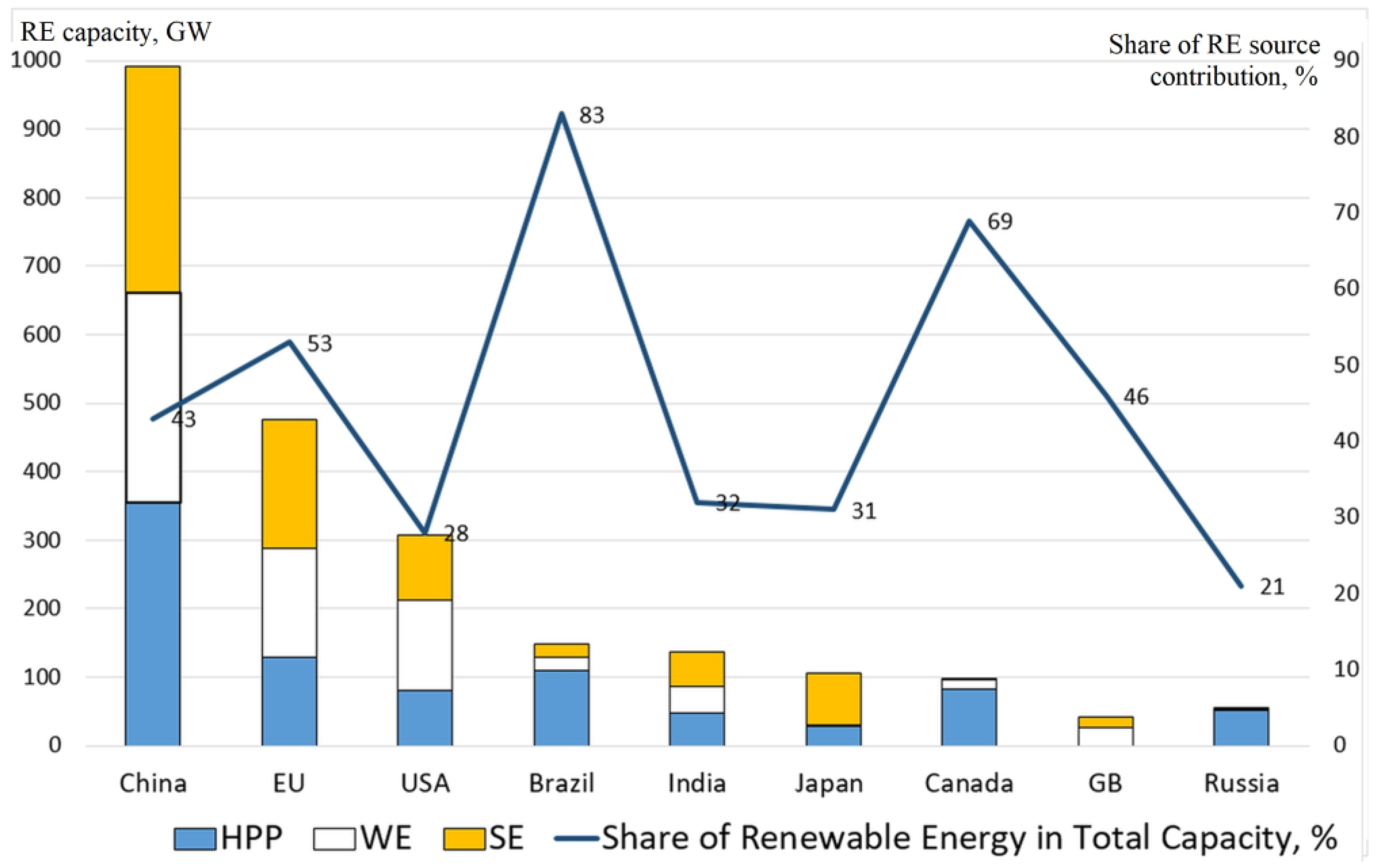
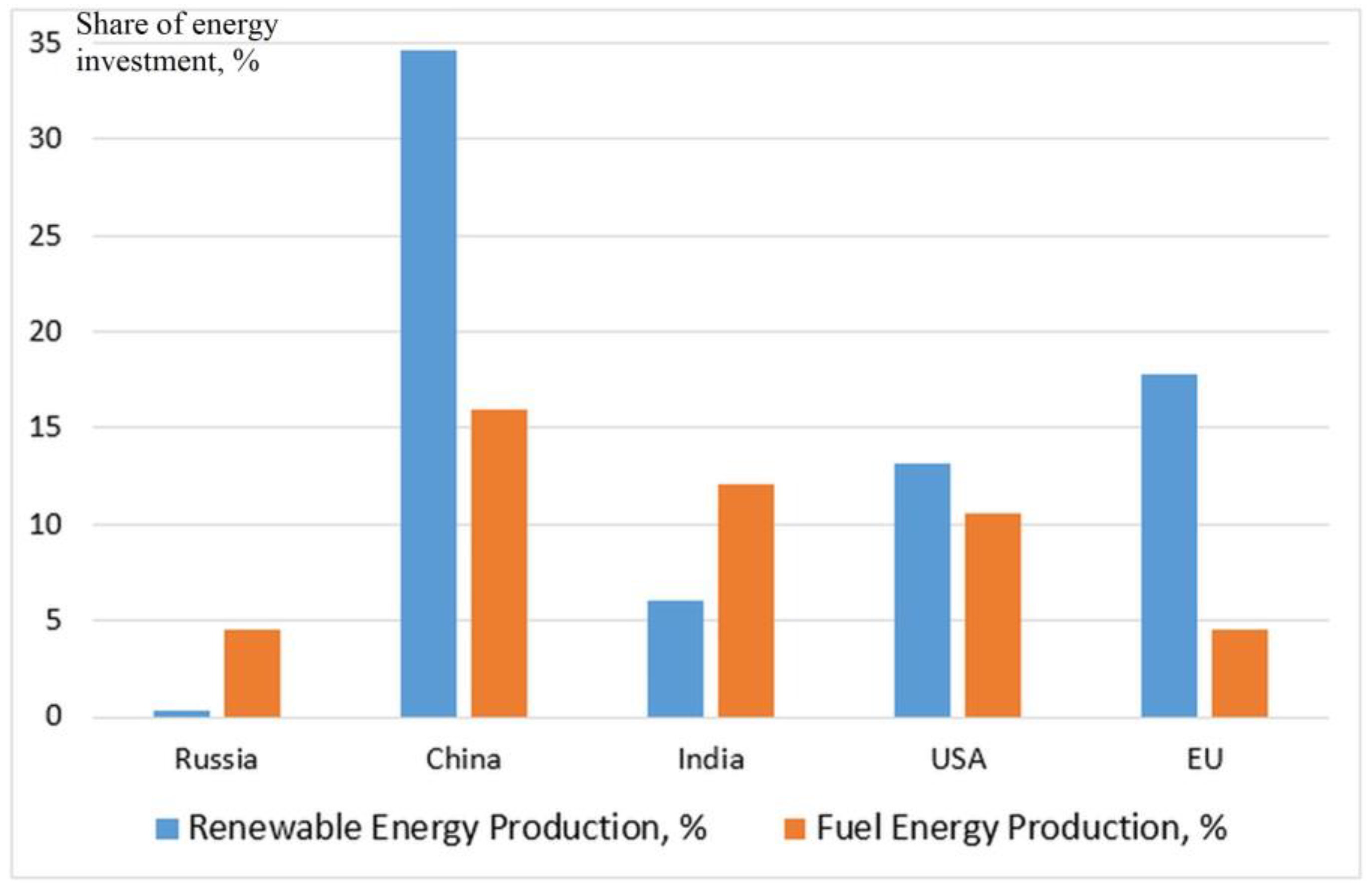
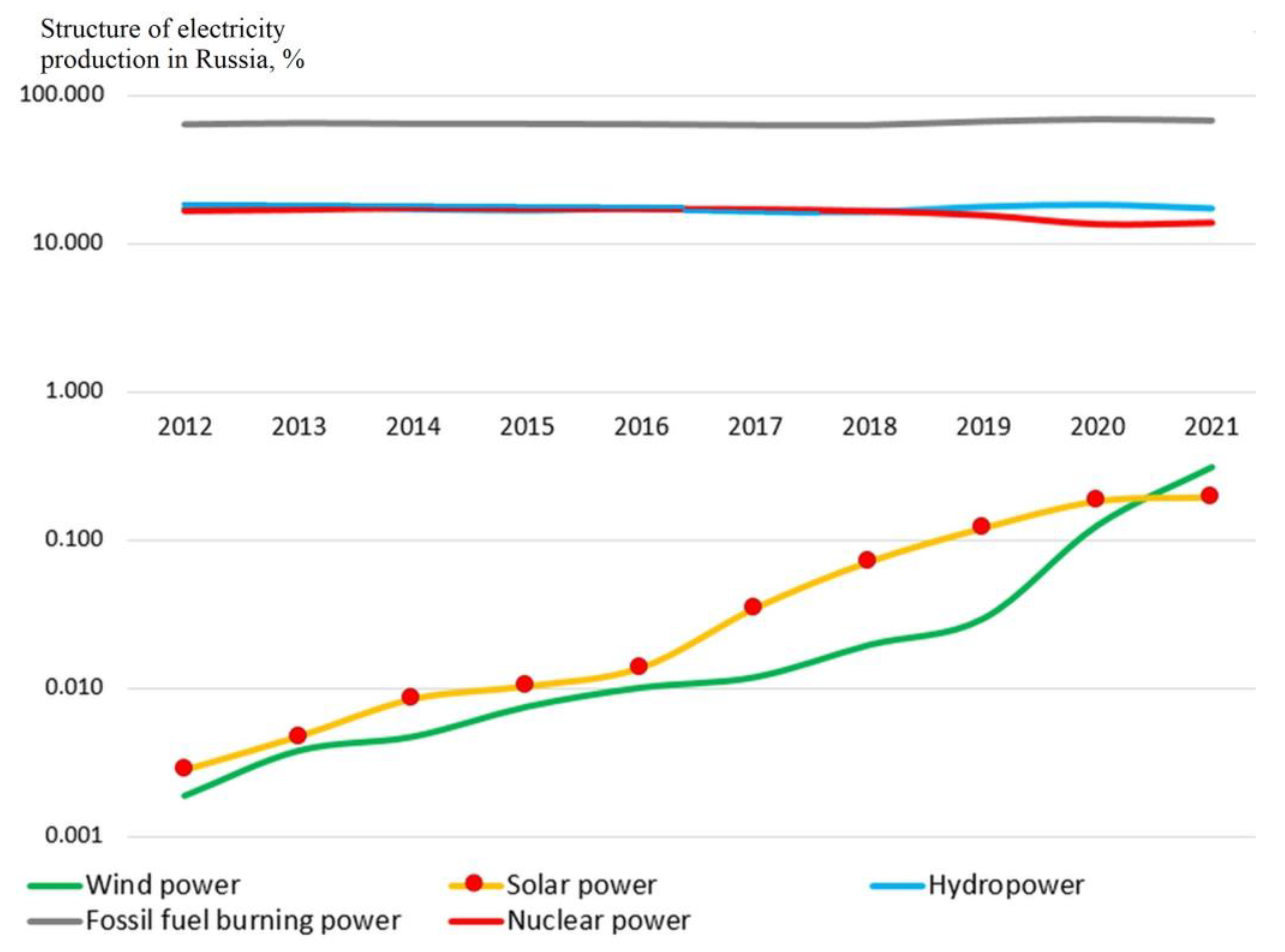

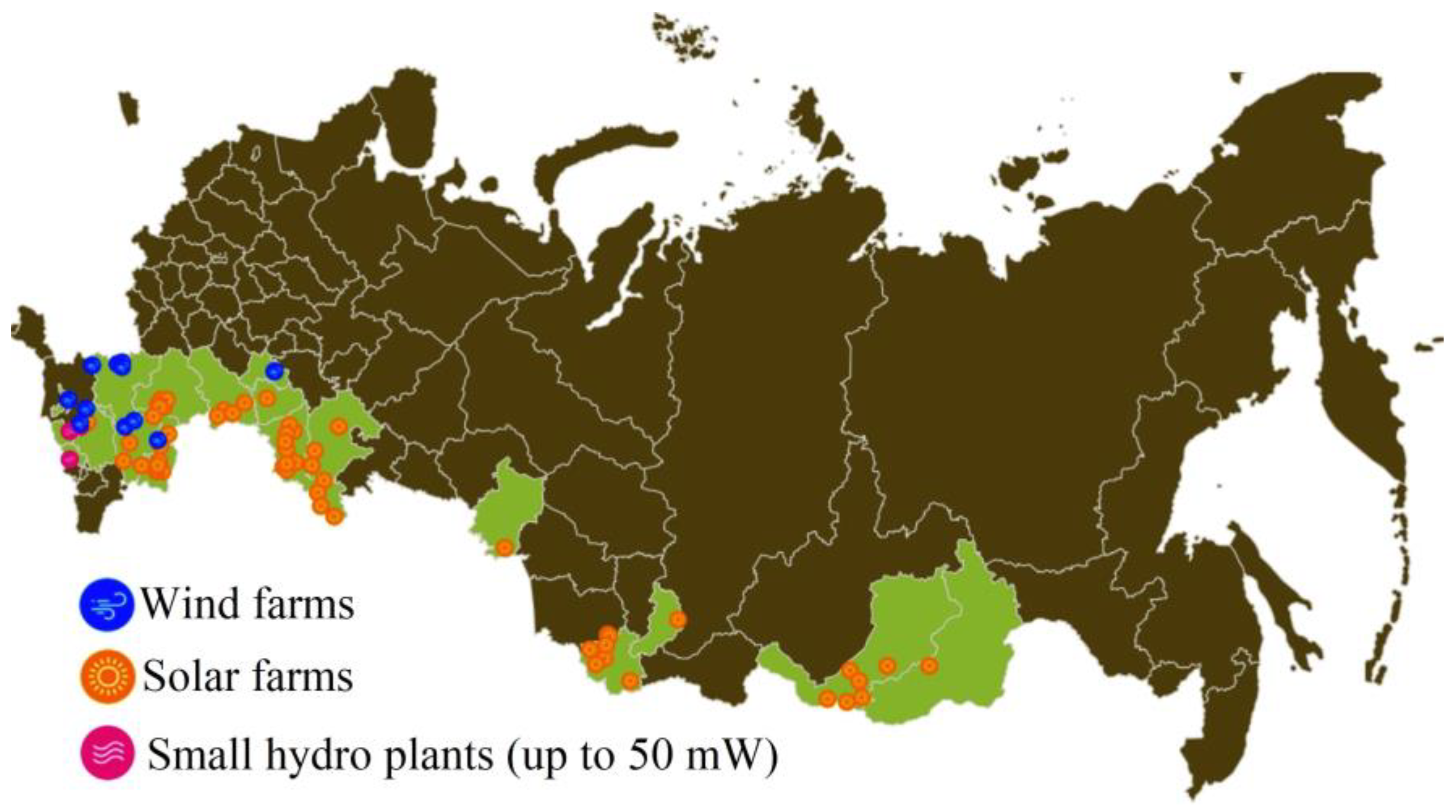
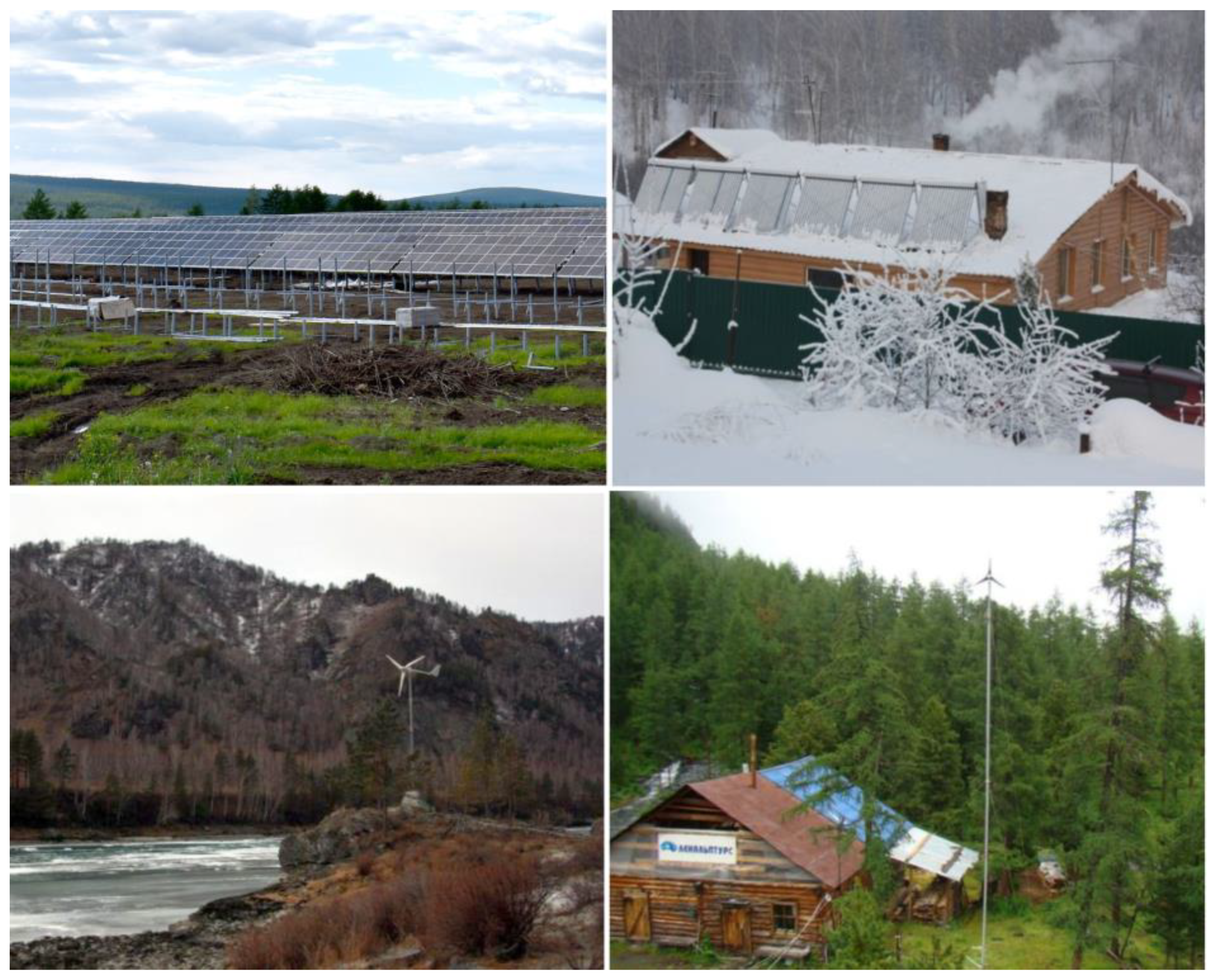
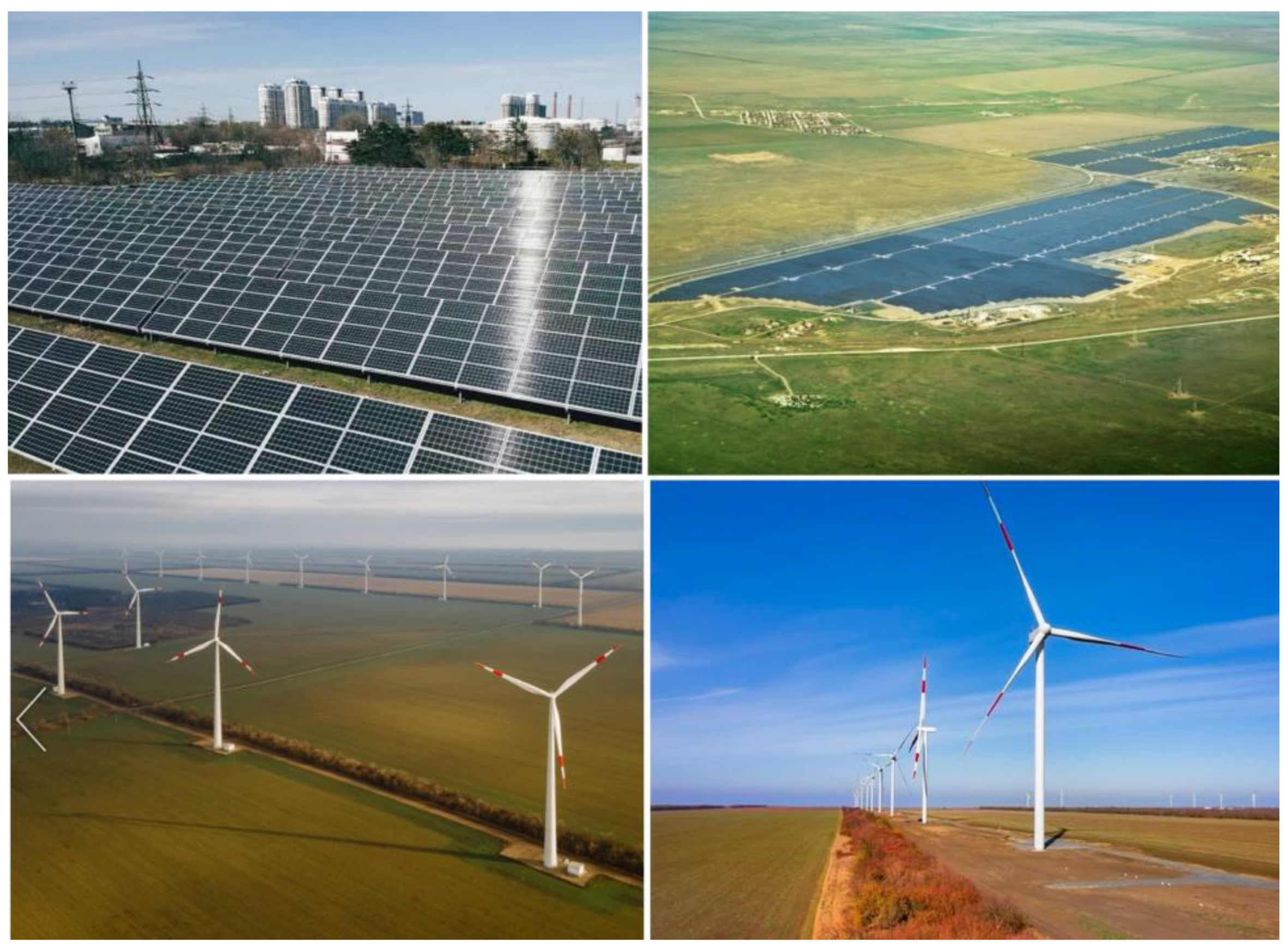
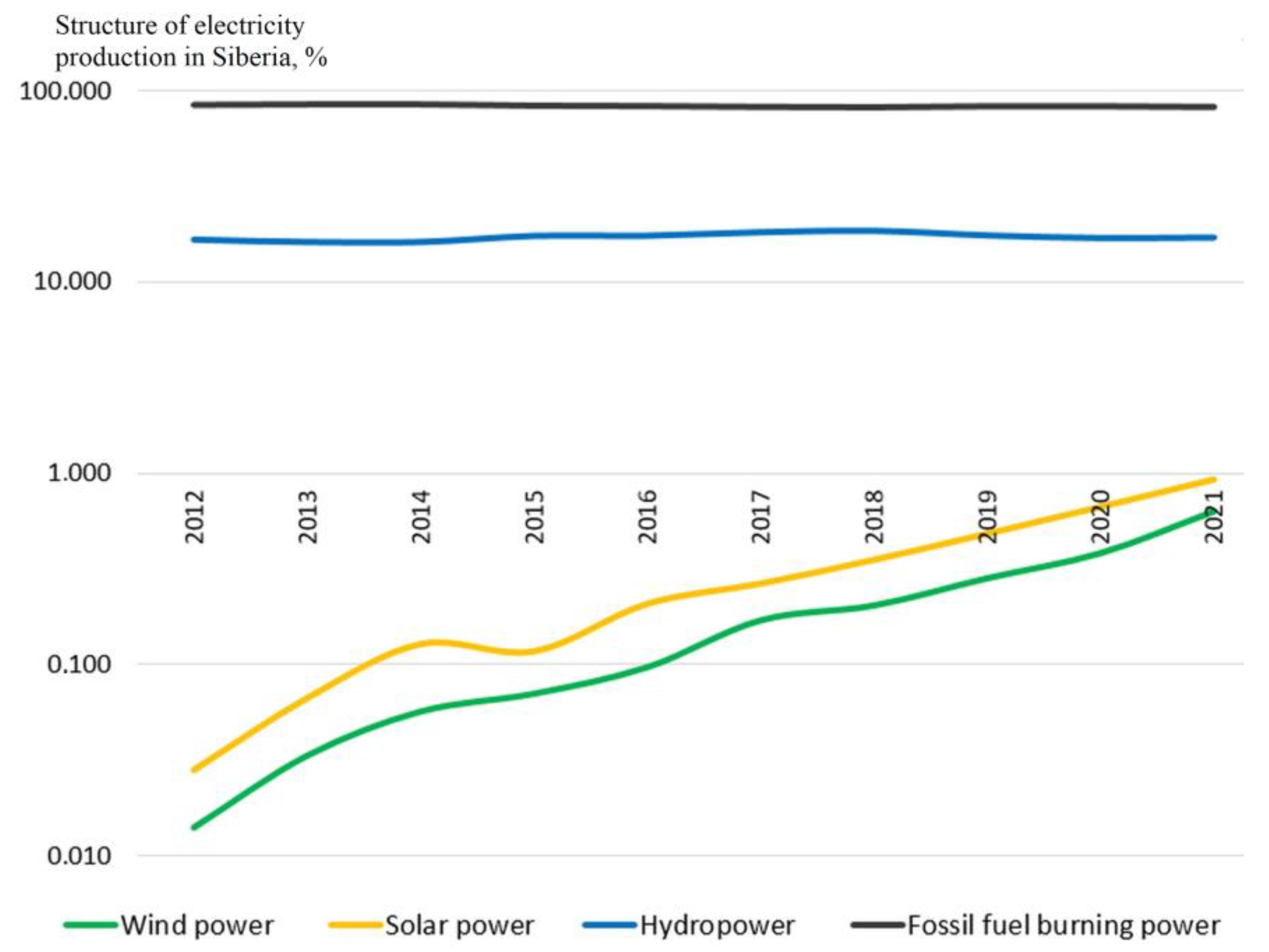
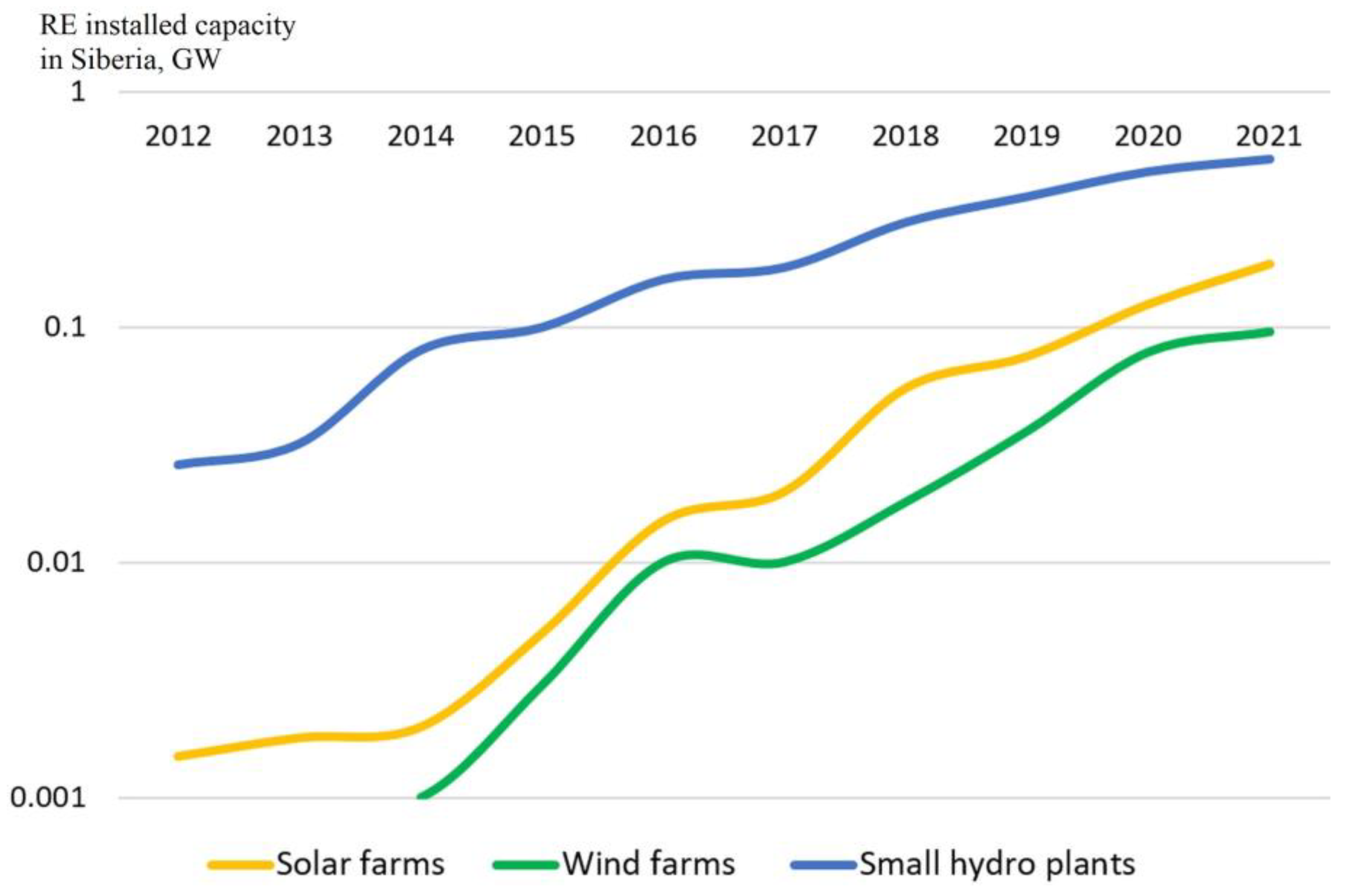
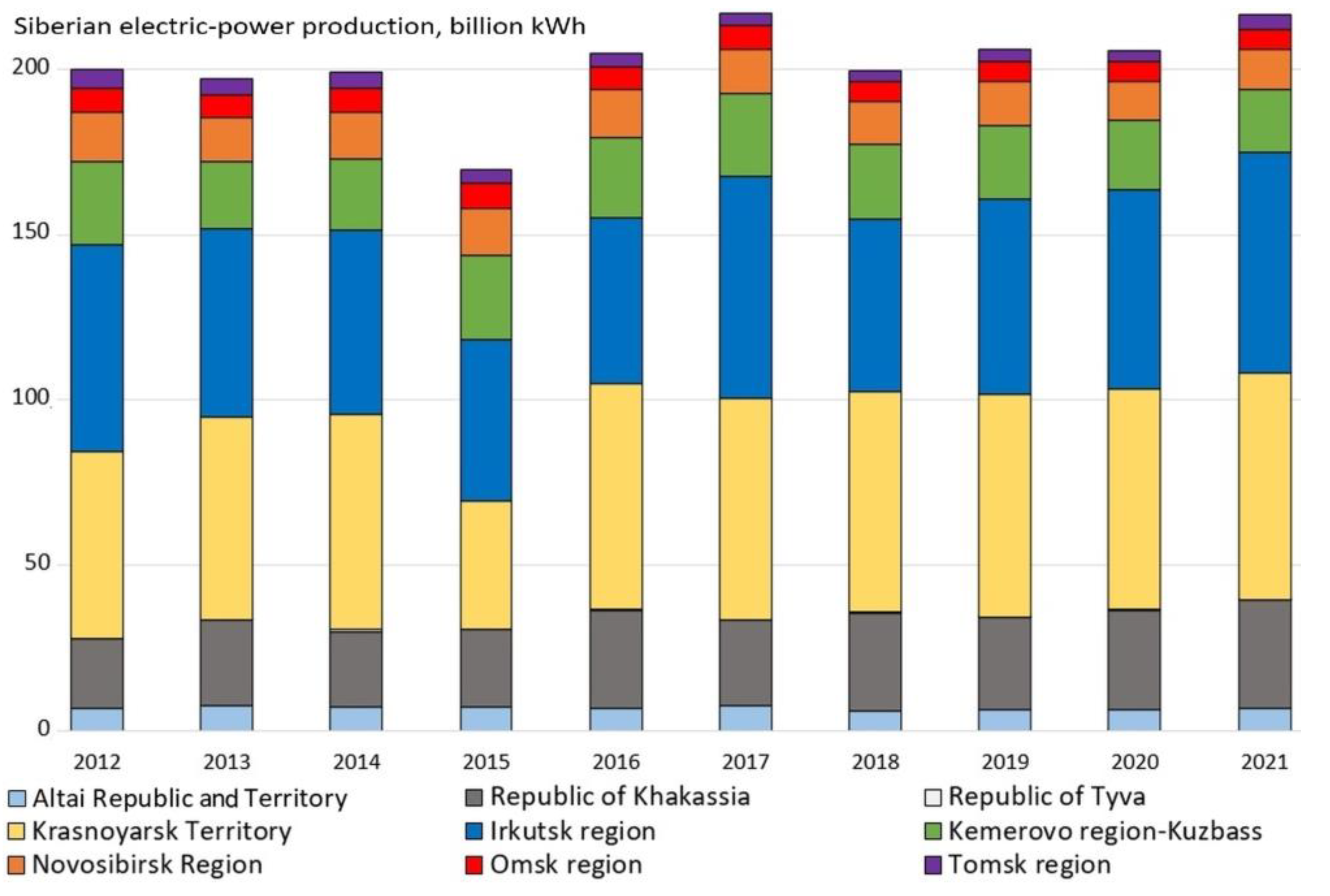
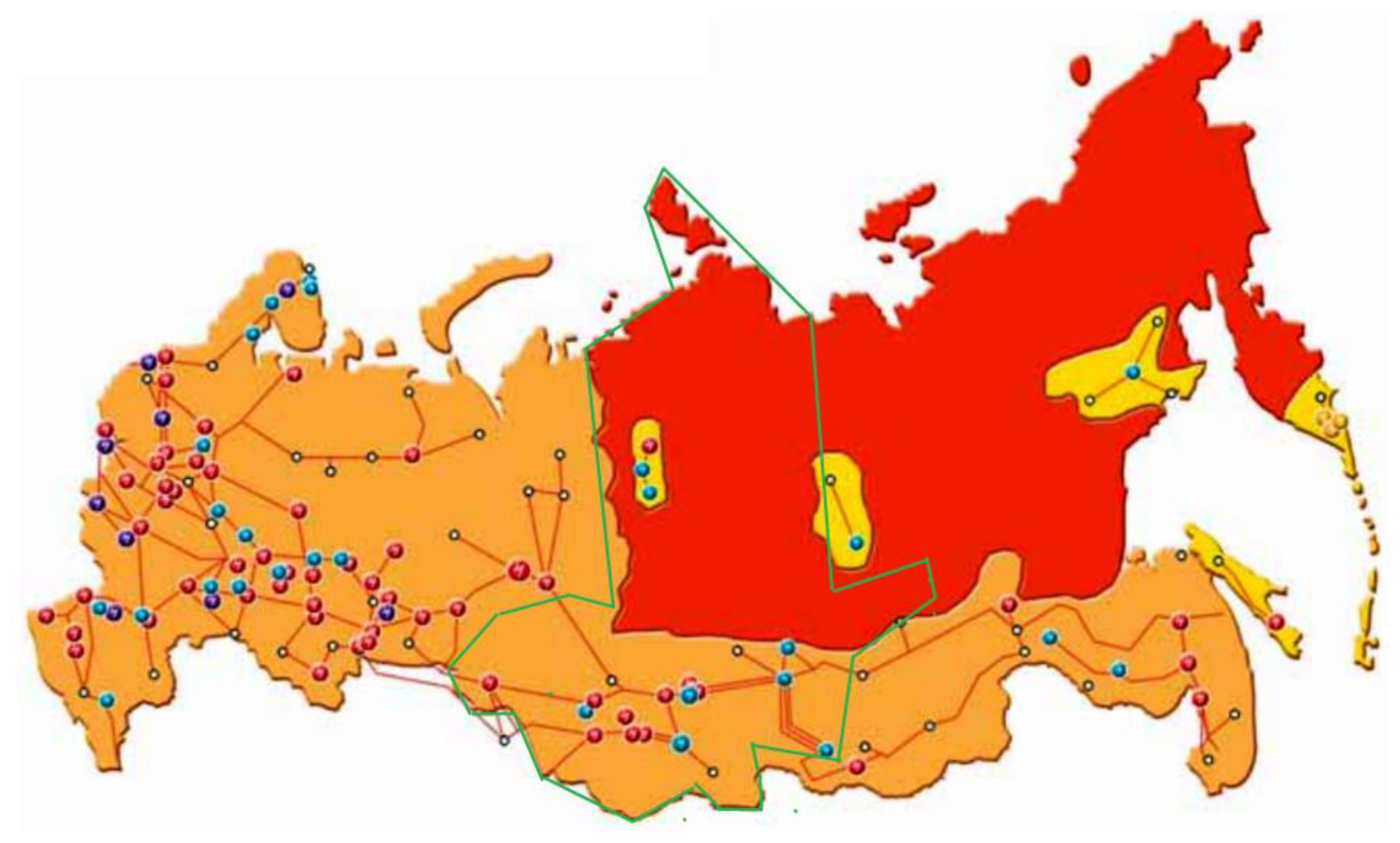
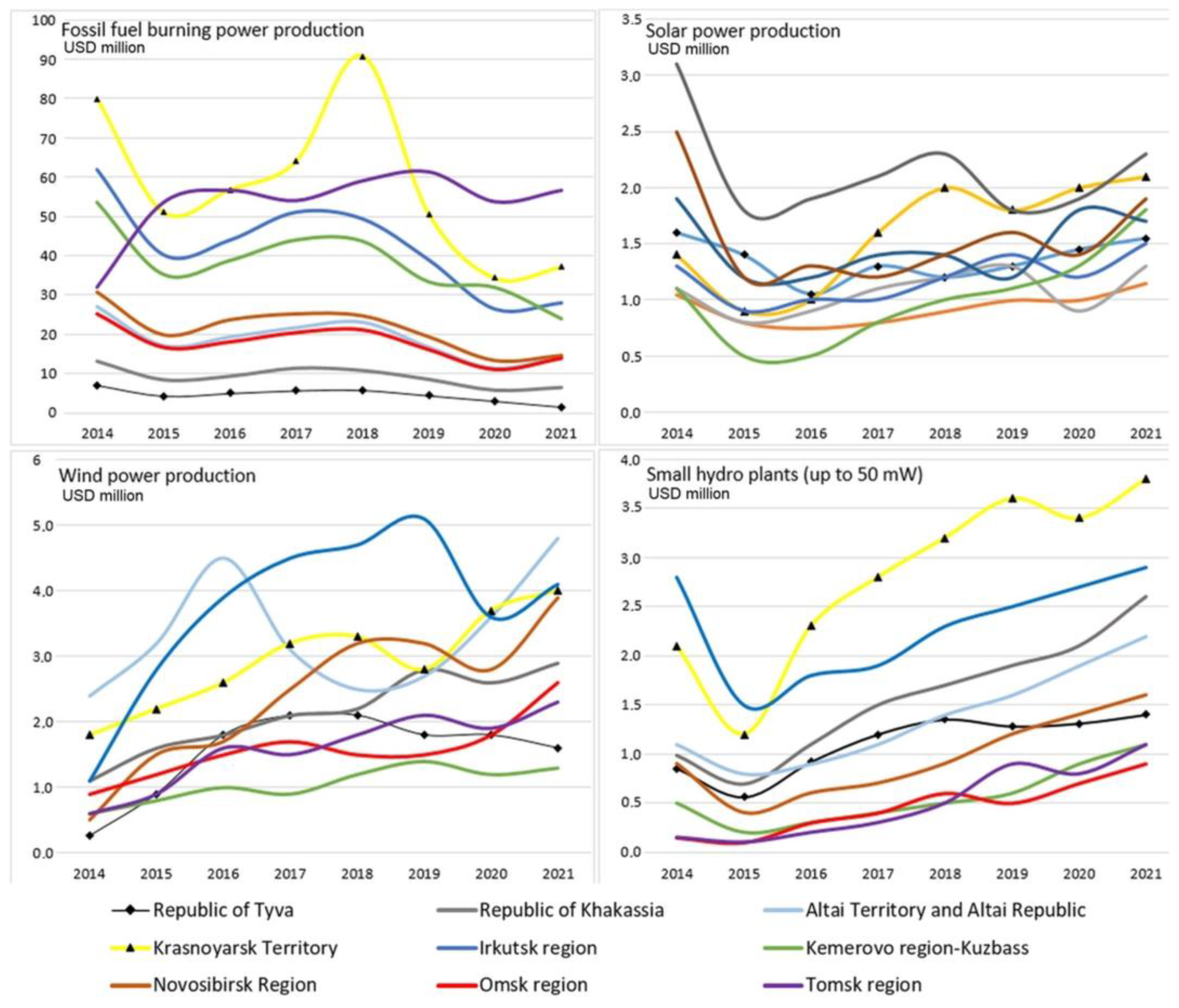
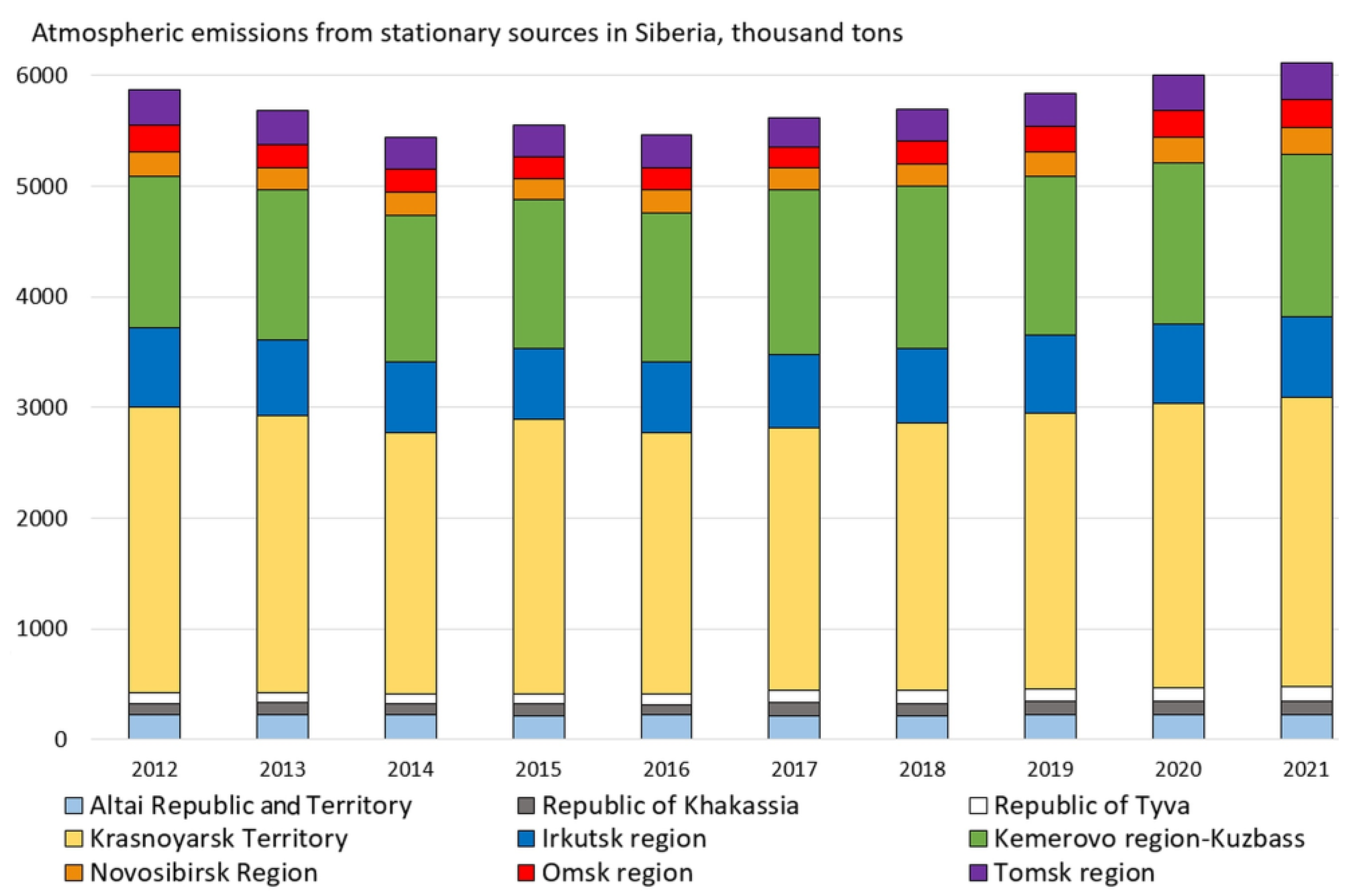
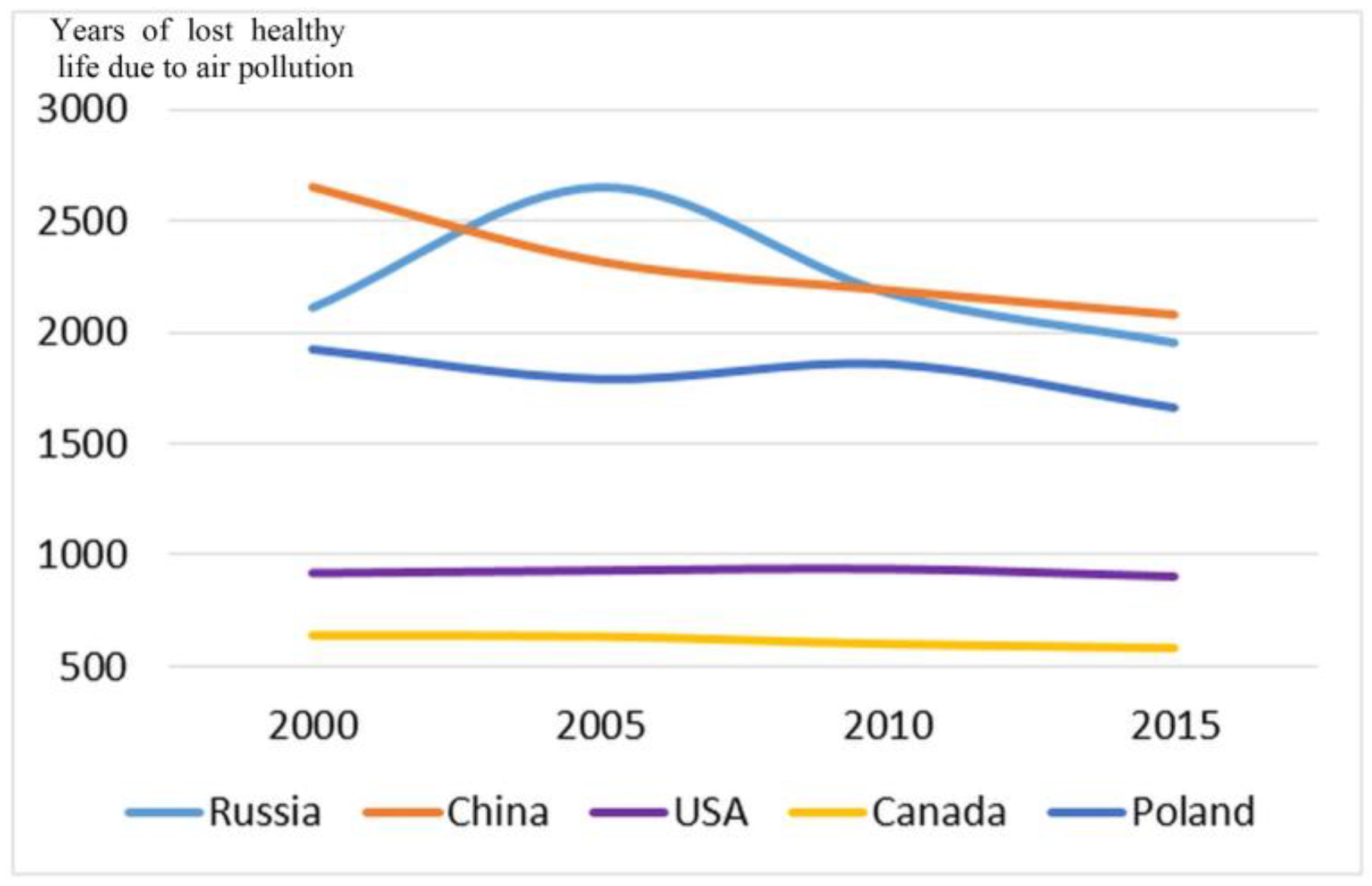
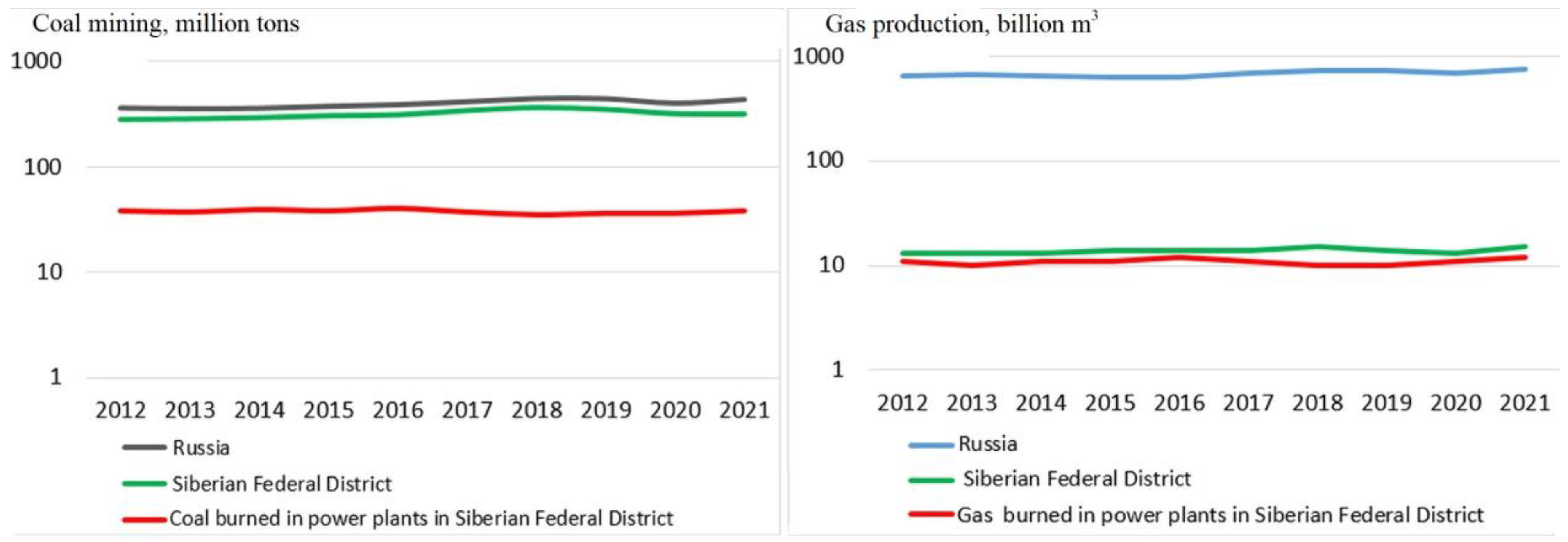

| Type of Energy Resource | Traditional | Nontraditional |
|---|---|---|
| Non-renewable |
|
|
| Renewable |
|
|
| 2012 | 2013 | 2014 | 2015 | 2016 | 2017 | 2018 | 2019 | 2020 | 2021 | |
|---|---|---|---|---|---|---|---|---|---|---|
| Wind power | 0.02 | 0.04 | 0.05 | 0.08 | 0.11 | 0.13 | 0.22 | 0.32 | 1.38 | 3.62 |
| Solar power | 0.03 | 0.05 | 0.09 | 0.11 | 0.15 | 0.38 | 0.8 | 1.3 | 1.99 | 2.25 |
| Hydropower | 184 | 186 | 181 | 178 | 187 | 180 | 183 | 190 | 197 | 199 |
| Nuclear power | 176 | 178 | 184 | 182 | 186 | 185 | 184 | 166 | 145 | 158 |
| Fossil fuel burning power | 685 | 691 | 688 | 690 | 701 | 695 | 712 | 722 | 751 | 786 |
| Total | 1069 | 1059 | 1064 | 1068 | 1091 | 1094 | 1121 | 1080 | 1089 | 1159 |
| 2012 | 2013 | 2014 | 2015 | 2016 | 2017 | 2018 | 2019 | 2020 | 2021 | |
|---|---|---|---|---|---|---|---|---|---|---|
| Wind farms | 0.05 | 0.08 | 0.11 | 0.12 | 0.15 | 0.16 | 0.18 | 0.2 | 1.01 | 2.05 |
| Solar farms | 0.06 | 0.09 | 0.12 | 0.14 | 0.25 | 0.53 | 0.82 | 1.42 | 1.67 | 1.98 |
| Small hydro plants (up to 50 mW) | 0.7 | 0.9 | 1.14 | 1.15 | 1.17 | 1.17 | 1.17 | 1.18 | 1.2 | 1.3 |
| 2012 | 2013 | 2014 | 2015 | 2016 | 2017 | 2018 | 2019 | 2020 | 2021 | |
|---|---|---|---|---|---|---|---|---|---|---|
| Share in GDP | 12.2 | 12.1 | 12.2 | 12.0 | 11.9 | 11.7 | 11.7 | 11.6 | 11.6 | 11.5 |
| Share in power generation (total) | 19.9 | 19.8 | 19.9 | 20.0 | 19.9 | 19.4 | 18.1 | 19.1 | 18.9 | 18.6 |
| Share of fossil fuel burning power generation | 25.7 | 25.3 | 25.7 | 25.5 | 25.4 | 24.9 | 23.0 | 23.4 | 22.4 | 22.3 |
| Share in electricity generation from renewable sources | 15.2 | 17.5 | 24.1 | 18.7 | 19.2 | 18.9 | 18.6 | 18.1 | 19.6 | 18.2 |
| Wind power | 11.6 | 11.9 | 12.5 | 11.6 | 10.8 | 10.6 | 10.8 | 10.7 | 11.2 | 11.6 |
| Solar power | 2.0 | 2.8 | 3.0 | 2.3 | 3.0 | 1.5 | 0.9 | 0.8 | 0.7 | 0.9 |
| Hydropower (including large hydro plants) | 28.1 | 28.3 | 27.5 | 28.1 | 28.5 | 28.2 | 28.4 | 28.8 | 29.1 | 29.3 |
| The share of atmospheric emissions from stationary sources | 34.0 | 31.8 | 30.0 | 31.1 | 31.0 | 32.3 | 33.3 | 33.8 | 32.4 | 32.7 |
| Area, Thousand km2 | Population, Million People | Number of Sunny Days per Year | Average Annual Wind Speed at a Height of 10 m, m/s | Average Maximum Wind Speed, m/s | |
|---|---|---|---|---|---|
| Southern Federal District | 420.8 | 16.6 | 150–300 | 2.3 | 21 |
| Siberian Federal District | 4361.7 | 16.6 | 80–120 | 2.8 | 24 |
| Oncological Pathologies | Respiratory Pathologies | |||||
|---|---|---|---|---|---|---|
| 2005 | 2018 | Growth, % | 2005 | 2018 | Growth, % | |
| Siberian Federal District | 231.3 | 283.5 | 22.6 | 74,488 | 76,815 | 3.1 |
| Republic of Tyva | 199.6 | 266.6 | 33.6 | 24,428 | 56,111 | 129.7 |
| Republic of Khakassia | 169.1 | 269.8 | 59.6 | 54,969 | 63,426 | 15.4 |
| Altai Republic and Territory | 251.8 | 300.7 | 18.5 | 65,927 | 64,237 | −2.6 |
| Krasnoyarsk Territory | 194.5 | 297.8 | 33.2 | 63,413 | 68,541 | 8.1 |
| Irkutsk region | 260.8 | 323.5 | 24.1 | 75,904 | 83,477 | 10.0 |
| Kemerovo region-Kuzbass | 204.6 | 253.3 | 24.6 | 62,838 | 70,915 | 12.9 |
| Novosibirsk Region | 252.9 | 277.5 | 9.8 | 90,866 | 94,847 | 4.4 |
| Omsk region | 252.1 | 294.3 | 16.7 | 78,855 | 63,317 | −19.7 |
| Tomsk region | 270.2 | 296.2 | 9.8 | 75,848 | 60,998 | −19.6 |
Disclaimer/Publisher’s Note: The statements, opinions and data contained in all publications are solely those of the individual author(s) and contributor(s) and not of MDPI and/or the editor(s). MDPI and/or the editor(s) disclaim responsibility for any injury to people or property resulting from any ideas, methods, instructions or products referred to in the content. |
© 2023 by the authors. Licensee MDPI, Basel, Switzerland. This article is an open access article distributed under the terms and conditions of the Creative Commons Attribution (CC BY) license (https://creativecommons.org/licenses/by/4.0/).
Share and Cite
Zhironkin, S.; Abu-Abed, F.; Dotsenko, E. The Development of Renewable Energy in Mineral Resource Clusters—The Case of the Siberian Federal District. Energies 2023, 16, 3843. https://doi.org/10.3390/en16093843
Zhironkin S, Abu-Abed F, Dotsenko E. The Development of Renewable Energy in Mineral Resource Clusters—The Case of the Siberian Federal District. Energies. 2023; 16(9):3843. https://doi.org/10.3390/en16093843
Chicago/Turabian StyleZhironkin, Sergey, Fares Abu-Abed, and Elena Dotsenko. 2023. "The Development of Renewable Energy in Mineral Resource Clusters—The Case of the Siberian Federal District" Energies 16, no. 9: 3843. https://doi.org/10.3390/en16093843
APA StyleZhironkin, S., Abu-Abed, F., & Dotsenko, E. (2023). The Development of Renewable Energy in Mineral Resource Clusters—The Case of the Siberian Federal District. Energies, 16(9), 3843. https://doi.org/10.3390/en16093843








